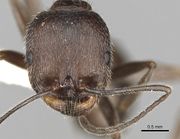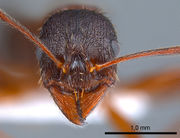Key to Aphaenogaster gibbosa group workers
This worker key is based on: Salata, S., Borowiec, L. 2018. Redescription of Aphaenogaster muschtaidica Emery, 1908 with a key to gibbosa species group. Asian Myrmecology 10, e010002, pp. 1-15 (DOI 10.20362/am.010002).
You may also be interested in
1
- Pronotum with transverse striation (Figs 13- 14) . . . . . 2
- Pronotum with irregular rugosity, striation or partially smooth (Figs 15-17) . . . . . 3
2
return to couplet #1
- Base of gaster with dense, longitudinal striation (Fig. 18). Spain . . . . . Aphaenogaster striativentris
- Base of gaster smooth (Fig. 19). Morocco . . . . . Aphaenogaster theryi
3
return to couplet #1
- Sculpture of pronotum reduced, its lateral surface at least in central part smooth and shiny (Fig. 15). Confirmed records from Iberian Peninsula and France . . . . . 4
- Surface of pronotum lacking smooth areas (Figs 16-17) Confirmed records from Maghreb, Transcaucasus, Italy and Switzerland . . . . . 5
4
return to couplet #3
- Head dorsum with smooth microreticulation, scape with adpressed setae, mesonotum humped, body brown . . . . . Aphaenogaster gibbosa
- Head dorsum smooth and shiny, scape with decumbent setae, mesonotum not humped, body brownish black to black ................ Aphaenogaster sp. Spain (an undescribed species from the Iberian Peninsula. )
5
return to couplet #3
- Propodeal spines small, tooth-like, with rounded tip (Fig. 20), longitudinal striation or reticulation limited to central part of frons (Fig. 23). Morocco . . . . . Aphaenogaster nadigi
- Propodeal spines triangular, with sharp tip (Figs 2, 21, 22), longitudinal striation or reticulation exceeding beyond central part of frons (Figs 5, 24, 25). Italy, Switzerland and Transcaucasus . . . . . 6
6
return to couplet #5
- Scape with decumbent setae, not longer than half of scape width (Fig. 26), Italy and Switzerland . . . . . Aphaenogaster italica
- Scape with at least suberect setae, longer than half of scape width (Figs 3, 27) . . . . . 7
7
return to couplet #6
- Scape with longitudinal rugae (Fig. 3), Transcaucasus . . . . . Aphaenogaster muschtaidica
- Scape lacking longitudinal rugae (Fig. 27), Maghreb . . . . . Aphaenogaster mauritanica





























